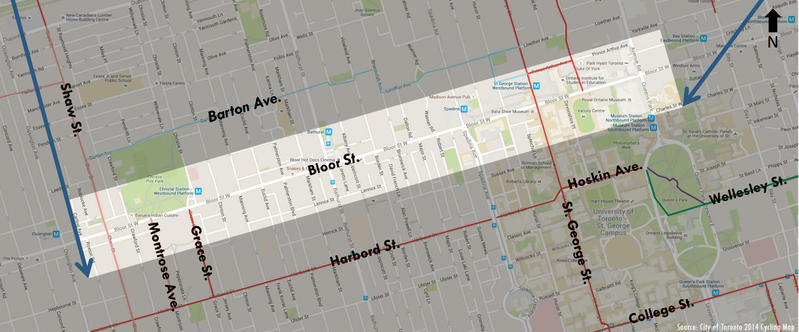Almost 40 years after Bloor Street was first identified as an ideal candidate for bike lanes, the city is taking another small step toward making it a reality.
At an open house this week, the city will show off possible designs for a pilot project on Bloor Street West between Shaw Street and Avenue Road, opening up the possibility of “Bikes on Bloor” by late summer. After
a survey, an earlier open house and many other stakeholder consultations, the city is presenting what it’s calling Option C: a curbside cycle track lane which features separation elements (parked cars or flexiposts) between the bike lane and the traffic lane, as well as between the bike lane and parked cars (the “door zone”). Options A, with no parking lanes at all, and B, with curbside parking have been set aside since the last open house.
 Bloor bike lanes pilot map
Bloor bike lanes pilot map
“Bloor and Danforth been sought-after by the cycling community for so long because, as streets in the city of Toronto go, they’re relatively rare: long east-west streets without streetcar tracks that connect a lot of places of origin with lots of destinations, with a vibrant shopping district,” says Jared Kolb, executive director of
Cycle Toronto. The advocacy group has been working on convincing business owners along Bloor and Danforth that bike lanes would be good for them and their customers. They’ve signed up more than 80 businesses who support the project and collected more than 8,000 signatures on its petition.
The city has seriously wrestled with the idea
since it commissioned a study in 1992. An earlier environmental assessment of bike lanes on Bloor and Danforth, which was eventually waylaid by Mayor Rob Ford’s administration, was supposed to look at the possibility of bike lanes on more than 20 kilometres of road from Kipling to Victoria Park.
The current initiative is much more bite-sized and, as a pilot project, will be subject to monitoring and re-evaluation. City staff will be making the case that Option C, which will be the focus of Wednesday’s meeting, will provide a more comfortable experience for cyclists, discourage motorists from parking, standing or stopping illegally in the bike lane, provide opportunities to improve the pedestrian environment and streetscape, and eliminate the need for motorists to yield to cyclists to access parking. On-street parking will alternate between the north and south sides to provide “an equitable approach to businesses and residents, and provides drivers with potential parking in either direction.”
Writer: Paul Gallant
Source: Jared Kolb, City of Toronto